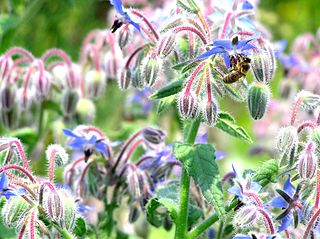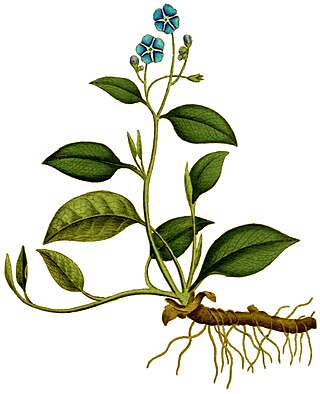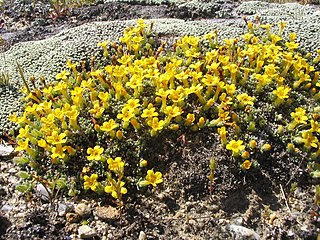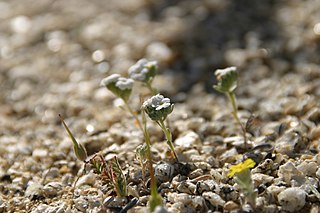
Boraginaceae, the borage or forget-me-notfamily, includes about 2,000 species of shrubs, trees, and herbs in 146 to 156 genera with a worldwide distribution.

Alstroemeriaceae is a family of flowering plants, with 254 known species in four genera, almost entirely native to the Americas, from Central America to southern South America. One species of Luzuriaga occurs in New Zealand, and the genus Drymophila is endemic to south-eastern Australia.

Myosotis is a genus of flowering plants in the family Boraginaceae. The name comes from the Ancient Greek μυοσωτίς "mouse's ear", which the foliage is thought to resemble. In the Northern Hemisphere, they are colloquially known as forget-me-nots or scorpion grasses. Myosotis alpestris is the official flower of Alaska and Dalsland, Sweden. Plants of the genus are commonly confused with Chatham Islands' forget-me-nots, which belong to the related genus Myosotidium.

Triadenum, known as marsh St. John's worts, is a small genus of flowering plants in the family Hypericaceae. The genus is characterized by opposite, blunt-tipped leaves and pink flowers with 9 stamens. They are distributed in North America and eastern Asia.

Ruppia, also known as the widgeonweeds, ditch grasses or widgeon grass, is the only extant genus in the family Ruppiaceae, with eight known species. These are aquatic plants widespread over much of the world. The genus name honours Heinrich Bernhard Rupp, a German botanist (1688-1719). They are widespread outside of frigid zones and the tropics.

Tiquilia canescens, the woody crinklemat or shrubby tiquilia, is a perennial, shrub in mid- to lower-elevation desert regions in the family Boraginaceae - Borage or the Forget-me-nots. It is found in the southwestern United States and Northwestern Mexico, in the states of California, Nevada, Arizona, Utah, New Mexico, Texas, Chihuahua, Sonora, and Baja California. It is a short, low-growing plant, seldom over 15 in tall.

Boraginoideae is a subfamily of the plant family Boraginaceae s.s, with about 42 genera. That family is defined in a much broader sense in the Angiosperm Phylogeny Group (APG) system of classification for flowering plants. The APG has not specified any subfamilial structure within Boraginaceae s.l.

Omphalodes (navelwort) is a genus of flowering plants in the family Boraginaceae, widely distributed in the temperate Northern Hemisphere. In spring they produce blue or white flowers similar to forget-me-nots.

Corynocarpus is the only genus of plants in the family Corynocarpaceae and includes five species. It is native to New Guinea, Australia, New Zealand, New Caledonia, and Vanuatu.

Codon is a small genus of plants from South Africa in the family Codonaceae in the order Boraginales. The genus Codon comprises two species.

Ellisia is a genus of flowering plants in the forget-me-not family (Boraginaceae), containing the sole species Ellisia nyctelea. It is native to North America, where it is also known as Aunt Lucy, false baby blue eyes, and waterpod. The genus was named in honor of British naturalist John Ellis, a contemporary of, and correspondent to, Carl Linnaeus. It was published and described by Linnaeus, in his book Species Plantarum ed.2 on page 1662 in 1763.
Mimophytum is a genus of flowering plants in the family Boraginaceae. The species occur in Northeastern Mexico and adjacent areas of Texas, United States. They are similar to the closely related genus Omphalodes but a distinct group.
Selkirkia is a genus of flowering plants in the family Boraginaceae. Three species occur on the South American mainland and one, Selkirkia berteroi, the first of the genus to be reported, is an endemic on Robinson Crusoe Island off the coast of Chile. It was previously considered a monotypic genus.

Carlos Adolfo Lehnebach is a New Zealand botanist. He is employed as a botany curator at the Museum of New Zealand Te Papa Tongarewa. Lehnebach has a master's degree and a PhD from Massey University.

Myosotis capitata is a species of flowering plant in the family Boraginaceae, endemic to the Campbell and Auckland Islands of New Zealand. Joseph Dalton Hooker described the species in his 19th century work Flora Antarctica. Plants of this species of forget-me-not are perennial and erect, and have ebracteate inflorescences and blue corollas. It is one of two native species of Myosotis in the New Zealand subantarctic islands, the other being M. antarctica, which can also have blue corollas.

Myosotis uniflora is a species of flowering plant in the family Boraginaceae, endemic to the South Island of New Zealand. Joseph Dalton Hooker described the species in 1867. Plants of this species of forget-me-not are perennial with a prostrate, compact, cushion or mat habit, short bracteate inflorescences, and cream to yellow corollas.

Huynhia is a genus of flowering plants belonging to the family Boraginaceae, from Asia.

Eremocarya is a genus of flowering plants in the family Boraginaceae. There are about 63 species and its native range extends through western United States to northwestern Mexico. It is part of subtribe of Amsinckiinae.
Malesherbia laraosensis is a member of Malesherbia (Passifloraceae) described in 2014 by Hamilton Beltran and Maximilian Weigend. It is the only member of the genus known to inhabit Laraos, Peru. It is described as a small shrub, with branch lengths up to 15 cm long, these features make it morphologically distinct from other Peruvian members of the genus. It has orange flowers with red tips, and flowers from May - July.

Myosotis saxosa is a species of flowering plant in the family Boraginaceae, endemic to the North Island of New Zealand. Joseph Dalton Hooker described the species in 1853. Plants of this species of forget-me-not are perennial rosettes with ebracteate inflorescences and white corollas with stamens that are exserted.

















